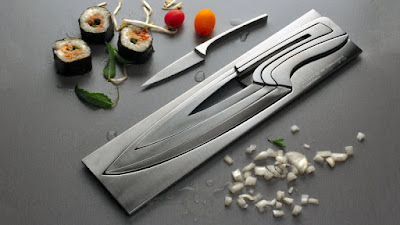Cutting Method Knowledge: Knife Knowledge
What is Knife Skill?
- Knife care and maintenance
- Knowledge of knife material, contraction, and how to use them effectively.
- The purpose of each knife
- Knowledge of the various cuts
 |
| Knife Knowledge |
Knife Care and Maintenance
- The key to the proper and efficient use of any knife is making sure that it is sharp.
- A knife with a sharp blade always works better and more safely because it cuts easily.
- Select the right knife for the intended job.
- Always use a cutting board or proper cutting surface when chopping, slicing, or mincing.
- Never cut on metal, glass, wood, or porcelain.
Knife Etiquette and Safety
- Always hold the knife by its handle
- Never attempt and catch a falling knife
- Use your own knife, do not borrow
- Pass the knife handle first or lay it down
- Do not allow the edge to hang over the cutting board
- Do not use a knife as an opener or for anything other them its intended purpose
- Do not leave the knife in the loose area or they are hidden (pot sink)
- Cary the knifepoint down, edge out and away from you
- Never store or use above waist level
- Always cut away from your body
 |
| Knife Etiquette and Safety |
Knife Component
- Bolster: The bolster is only found on forged knives. It is a thick band of steel between the heel and the handle that helps balance the knife and prevents the user's hand from slipping across the blade.
- Butt: The butt is the end of the knife handle.
- Edge: The edge is the sharpened part of the knife blade that extends from the heel to the tip. Maintaining a sharp edge is crucial for user safety and maximum effectiveness.
- Handle: Also known as the scales, the handle provides the knife's gripping surface.
- Heel: The heel is the rear portion of the blade and is most often used to cut thick or tough products where more force is required.
- Point: This functions as the piercing tool of the blade.
- Spine: The spine is the top of the blade opposite the edge.
- Tang: The tang is the part of the blade that extends into the handle and helps provide balance. Full tang blades are considered superior in balance and durability. A sub tang or half tang is less durable but more economic.
- Tip: The tip is the front quarter of the blade that does most of the cutting and separating. Pointed tips are ideal for piercing and cutting small portions. Rounded tips are ideal for cutting or slicing thin portions
 |
| Knife Component |
How to Sharpen Your Knife
Sharpness
- Sharpness is not just a function of creating a super-thin edge that will readily sever free-hanging nose hairs, it’s also a function of shape and intended purpose.
 |
| Wet Stone |
Sharpen Knife With Wet Stone
- Place the whetstone in water deep enough to cover soak 10-20 minutes until no bubbles emerge from the stones.
- With the tip pointing away from you, a right-handed person should start to sharpen on the right side of the blade.
- Hold the knife tightly. Draw the edge backward and forward at an angle of 10-20 degrees.
- Repeat the same process for the other side of the blade. This side needs less work and when the burrs are gone, you are finished. The powder that forms on the stone is essential to the sharpening process and should not be rinsed away.
- After sharpening, the knives should be finished on steel and then washed in water and dried completely with a soft towel
NOTE:
- Sharpen the knife with wet stone for only 1 or 2 months or how often it is used
- Do not sharpen the knife too often because it can run out the tip and edge of the knife
 |
| Sharpen knife with wet stone |
 |
| The steel to keep the edges in alignment. |
Sharpen Knife with Sharpening Steel
- The tip of the blade should point upward.
- Hold the sharpening steel vertically firmly in your hand. Hold the knife firmly by the handle.
- Move the blade from the back wide part of the knife) to the point.
- Hold the knife between an angle of 10 and 20 degrees with slight pressure over the steel
 |
| Sharpening Steel |
 |
| Sharpening knife with steel |
Read: Beef Cutting
Cleaning, Sanitizing and Storing Knife
- Never leave your knife on or in the pot sink
- Do not clean in the dishwasher
- Clean knives in hot soapy water, rinse, dry then sanitize
- To store, use clean sleeves, knife case, an in-wall, or table-mounted rack.
german steel knifeOnline shopping for Kitchen Knives & Accessories from a great selection of Cutlery Sets, Specialty Knives, Sharpeners, Cutting Boards, & more at everyday low prices.
ReplyDeletefull tang chef knife Online shopping for Kitchen Knives & Accessories from a great selection of Cutlery Sets, Specialty Knives, Sharpeners, Cutting Boards, & more at everyday low prices.
ReplyDeleteHi; there...!
ReplyDeleteThe way you presented all the information is so attractive. Knowledge you are
sharing seems to very precious and really it is adorable. Everyone will help to get
know more and more about their queries.
We are absolutely thankful to your dedicated work. If someone like to know
more about how to choose the best kitchen knife or best knife under $50 then hit this
thread without wasting much time.
This is really nice information you posted, It's very informative and definitely, will be helpful for those who are looking for Australian knives. To know more about visit Australian knives
ReplyDelete